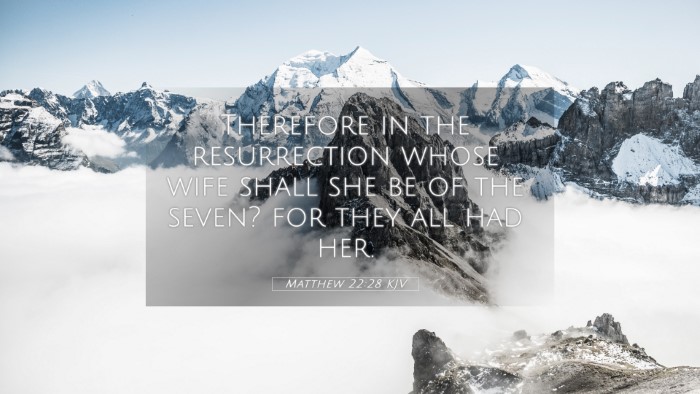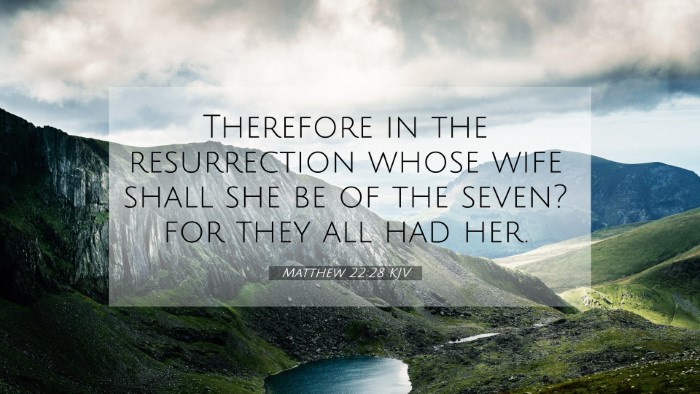Understanding Matthew 22:28
Matthew 22:28 states: "Therefore in the resurrection, whose wife will she be of the seven? For they all had her." This verse belongs to a larger discourse where the Sadducees confront Jesus regarding the resurrection and marriage.
Summarized Meaning
The Sadducees, who denied the resurrection, pose a situation to Jesus using the Law of Moses, which allowed a man to marry his deceased brother’s widow to preserve the family lineage (Deuteronomy 25:5). Their question, as elucidated by various commentaries, seeks to trap Jesus by presenting an absurd scenario—if a woman marries seven brothers in succession, whose wife will she be in the afterlife?
Insights from Public Domain Commentaries
-
Matthew Henry: Comments that the Sadducees' question reveals their misunderstanding of both the scriptures and the power of God. Their logic is flawed, failing to recognize that resurrection life is fundamentally different from earthly existence, where marriage is applicable.
-
Albert Barnes: He emphasizes that the hypothetical situation illustrates the Sadducees' lack of belief in an afterlife. Barnes points out that Jesus' response illustrates that in the resurrection state, earthly relationships are transformed, as the saints will be “as angels” (Matthew 22:30).
-
Adam Clarke: Clarke notes that the Sadducees attempted to use the Law to discredit the resurrection. He explains the context of their question and concludes that Jesus' eventual answer rebukes their erroneous assumption about the nature of God’s eternal kingdom.
Bible Cross References
This verse intersects with several others that inform the discussion of resurrection and relationships:
- Deuteronomy 25:5 - Provides the cultural and legal background regarding levirate marriage.
- Matthew 22:30 - Jesus clarifies the nature of existence after resurrection, stating that people will neither marry nor be given in marriage.
- 1 Corinthians 15:35-44 - Discusses the resurrection body and the transformation that occurs, highlighting its spiritual nature.
- Luke 20:34-36 - A parallel passage where Jesus explains that those who have been resurrected are like angels, thus not necessitating marriage.
- Mark 12:25 - Another retelling of the Sadducees' question, reinforcing Jesus' unified response regarding the resurrection.
- Romans 8:11 - Connects the power of resurrection through the Spirit, giving believers hope of eternal life.
- Philippians 3:20-21 - Reflects on our citizenship in heaven and the transformative power of our future resurrection.
Connections Between the Verses
The connections between these verses highlight thematic elements of understanding resurrection, the nature of afterlife relationships, and God's divine order in contrast to human logic. By exploring these parallels, readers can better grasp the core message Jesus imparts regarding eternal life.
Tools for Bible Cross-Referencing
To enhance your study of Matthew 22:28 and its related themes, consider using the following:
- Bible Concordance - Helps locate terms and associated verses.
- Bible Cross-Reference Guide - Offers thematic connections and contextual insights.
- Bible Chain References - Establishes links between verses to assist in continual exploration of biblical themes.
Conclusion
Matthew 22:28 serves as a crucial point for understanding the dynamics of resurrection in Christian theology. The insights from established commentaries illuminate the text and invite further exploration of related scriptures through tools designed for comprehensive cross-referencing.


